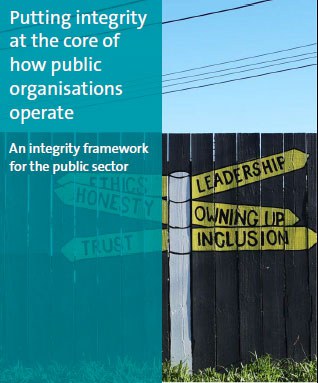A statement of values
Why it matters: Provides a shared understanding of, and commitment, to "what your organisation stands for"
A vision statement and a set of values form the foundation for an organisation, setting out its purpose and the expectations for its culture. Together, they help align the way you do your work with your strategic objectives.
I have worked here 48 years. What has kept me here is the people, great people, and good integrity. We know what we are working for.”
Government department manager
When organisational values are embedded, they underpin the decision-making and actions of staff and empower individuals to call out behaviours that do not align.
Values are the cornerstone of integrity because they:
- Help staff understand their workplace and make (ethical) decisions: Values guide decision-making and actions. They clarify what the organisation stands for.
- Align your organisation: Shared values communicate the bigger purpose that staff work towards together. They provide clarity on what is acceptable and empower staff to have difficult conversations in a safe environment.
- Improve motivation: Teams that have explicit values, and consistently demonstrate them, are more engaged because they know how everyone is expected to behave. Understanding and agreeing with the organisation's values gives staff collective buy-in and a sense of belonging.
- Communicate to the public: Organisational values can help communicate that an organisation takes integrity seriously and can be trusted.
What it looks like: A statement of what your organisation stands for and the culture you seek
Each organisation needs to put integrity in its own context in relation to its vision and purpose21 and the core values to which it is committed and wishes to be held accountable.22
Establishing organisational values begins with a clear understanding of the overall organisational purpose.
It is not enough just to have values. There also needs to be a process to work through what the values look like in practice. This process should give attention to the diversity of beliefs and worldviews within current workplaces and ensure an inclusive environment where different voices are heard and respected. This gives all staff a shared understanding of what each value means and looks like, and what they are being held accountable for.
Staff talk every day in their morning debrief about the values, picking one to talk about it, sharing experiences that resonate.”
Government department staff member
The Public Service Act 2020 sets out the purpose and principles (political neutrality, free and frank advice, merit-based appointment, open government, and stewardship) for public service organisations.23 It also includes the values (impartial, accountable, trustworthy, respectful, responsive) that underpin the public service.24 They go to the heart of maintaining public trust and confidence and set the expectations for all public service employees regardless of which organisation they work for. As well as these principles and values, organisations can add additional values that reflect their organisation's unique role and responsibilities.
 |
It's worth considering...
|
21: Paine, Lynn S (1994), "Managing for Organizational Integrity", Harvard Business Review.
22: CIMA and Institute of Business Ethics (2017), Embedding ethical values: A guide for CIMA partners.
23: By public service organisations, we mean any of the organisations listed in section 17(2) of the Public Service Act 2020. This includes all public service departments, departmental agencies, Crown agents, and statutory Crown entities.
24: The public service values are given effect through minimum standards that the Public Service Commissioner sets. Employment management processes in an agency address behaviour inconsistent with minimum standards.


